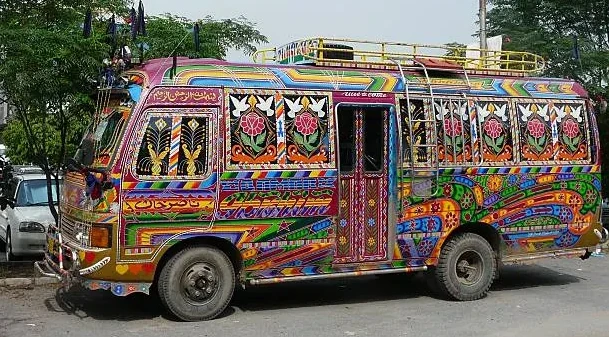“Scattered here and there are large conical-roofed pavilions, with a kiosk in the center selling papers, comic books, magazines, fruit juices, and snacks. (Also cigarettes—the Ecotopians have not managed to stamp out smoking!) The pavilions turn out to be stops on the minibus system, and people wait there out of the rain. These buses are comical battery-driven contraptions, resembling the antique cable cars that San Franciscans were once so fond of. They are driverless, and are steered and stopped by an electronic gadget that follows wires buried in the street. (A safety bumper stops them in case someone fails to get out of the way.) To enable people to get on and off quickly, during the 15 seconds the bus stops, the floor is only a few inches above ground level; the wheels are at the extreme ends of the vehicle. Rows of seats face outward, so on a short trip you simply sit down momentarily, or stand and hang onto one of the hand grips. In bad weather fringed fabric roofs can be extended outward to provide more shelter.
These buses creep along at about ten miles an hour, but they come every five minutes or so.”
“Ecotopia” by Ernest Callenbach
“After work, I head downtown instead of going straight home. I type my destination into my phone and walk up to the nearest bus stop. After a short while, a bus emerges on a busy corner and comes to a halt in front of me. The front door slides open and I climb in. My designated seat awaits me inside. The citywide, centralized system continuously modifies bus routes and optimizes schedules according to our needs. Snaking through the buildings looming above us, the bus swallows up passengers and spews them out, making several stops along the way. As we reach my stop, the android driver pulls up to the curb and drops me off.
“Thank you, and have a great day!” The driver flashes me a mechanical smile as I step out.
“Thanks. You, too,” I mumble before the door slides shut.”
“A Life With Cibi” by Natsumi Tanaka
Buses are an important means of transport in many THS cities.
To combat congestion and pollution, many cities have “no‑car” zones where non‑commercial transport is prohibited.
To travel any distance requires public transport such buses, taxis, or route‑taxis.
Exception licenses for private vehicles will be expensive and difficult to come by.
In many settlements not on Earth, public transport was given priority, and within the interior of these colonies there are few privately owned vehicles nor much need for them.
The buses described in “Ecotopia” reflect their San Francisco urban setting.
Buses in other climates are likely to be more contained. Buses that travel more major roads are likely to be faster on certain parts of their journey.
The extract from “A Life With Cibi” suggests that a bus would be programmed (via a phone or similar electronic device, such as a VII) with the exact locations its passengers want, and makes stops as near as possible for them.
Whether buses are automated, have an android driver or even a baseline human driver, is up to the GM. This will depend on the location and the availability and perception of technology in that area.

Many cities or countries are famous for their iconic highly decorated buses and public transport. Examples include the Philippines, Malta, South America, Pakistan and India.
By 2100, means of decoration may include holograms, VR, V-tags and interactive components.
While most of the THS-verse takes the bus, the stigma against buses and those who use them persists in many parts of the USA.